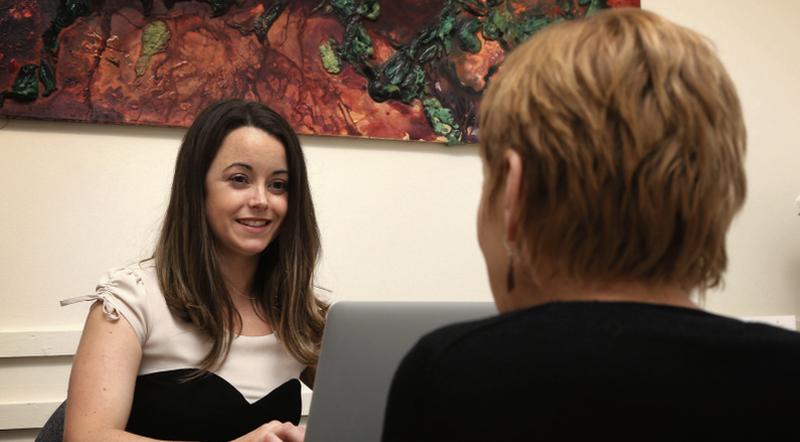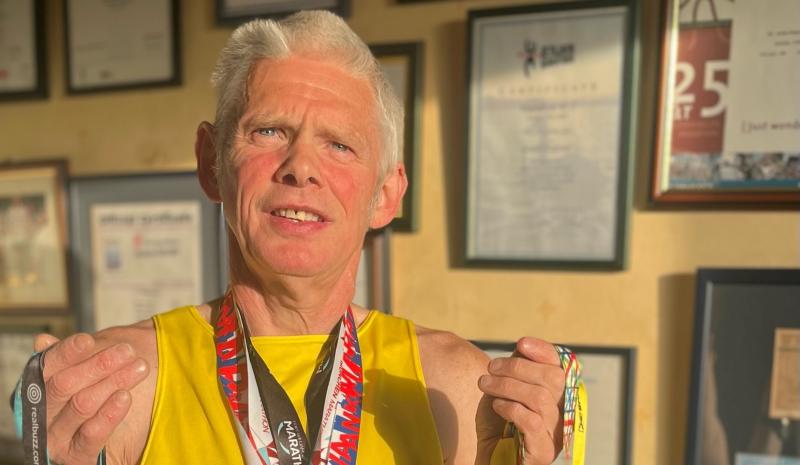Featured
How to eat your way to health and happiness

Lifestyle – Judy Murphy meets nutritional therapist Niamh Burke who reveals why feeding the gut is so critical
When Niamh Burke was diagnosed with an underactive thyroid recently, she was understandably upset.
But then she looked on the bright side.
Niamh decided she would use her condition and its treatment as a way of carrying out research for her clients. After all, that’s what she’s been doing for years.
Niamh is a nutritional therapist who specialises in fat loss, female hormones and metabolic repair – and her appearance alone would inspire confidence. Standing at just over five foot, she radiates energy, with clear skin and eyes and shiny, healthy hair.
But it wasn’t always this way, she says, as we sit for a chat in her comfortable consulting room overlooking the canal in the city’s Dominick Street. Niamh’s hormones were out of kilter for years, although she didn’t know it. But, it was only when she addressed the underlying hormonal issues that she resolved a range of psychological and physical problems.
The 34-year-old, who grew up in Athlone to Galway parents explains that she “suffered from a bit of anxiety growing up.”
“And I always had what I’d class as puppy fat, so I was always trying to lose weight”.
After her Leaving Cert, Niamh moved to Galway to study art at GMIT and took up intensive training to try and shift the pounds. That included running for about five hours a week, but with little success.
“I wasn’t losing much weight and when I’d stop running, any weight I’d lost would come right back. And I wasn’t feeling great.”
In a bid to eat healthily, she was consuming smoothies constantly, but really “I was just pouring sugar into myself”.
Thinking that she needed more exercise, Niamh increased her training regime. By the time she’d finished college, she was working out five times a week in the gym as well as cycling to work in Milano restaurant where she worked fulltime as a waitress.
“I used to go spinning, I was running on the treadmill, doing bootcamp and HIT (High-Intensity-Training).”
While doing all this high-intensity exercise, Niamh started feeling really stressed and getting panic attacks. But she didn’t join the dots.
“Nothing in my life was particularly stressful, but I was waking in the middle of the night with anxiety.”
And because she was doing so much cardio, she was craving sugar constantly. Her skin was a mess and she suffered from spots.
Niamh consulted a counsellor to explore any unresolved difficulties from childhood that might have been causing her anxiety. After a few sessions, the counsellor said there were no issues.
Niamh then decided to see if there was another explanation. She’d studied beauty therapy while waitressing and learned a lot about the importance of good diet. A period in Australia – where people are very health-conscious – also led her towards nutrition.
She trained as a nutritional therapist with the Dublin-based Institute of Health Sciences, attending part-time for four years.
“By the end of college, after what I’d learned about hormones, my anxiety attacks had stopped”.
For more, read this week’s Connacht Tribune.
Connacht Tribune
West has lower cancer survival rates than rest

Significant state investment is required to address ‘shocking’ inequalities that leave cancer patients in the West at greater risk of succumbing to the disease.
A meeting of Regional Health Forum West heard that survival rates for breast, lung and colorectal cancers than the national average, and with the most deprived quintile of the population, the West’s residents faced poorer outcomes from a cancer diagnosis.
For breast cancer patients, the five-year survival rate was 80% in the West versus 85% nationally; for lung cancer patients it was 16.7% in the west against a 19.5% national survival rate; and in the West’s colorectal cancer patients, there was a 62.6% survival rate where the national average was 63.1%.
These startling statistics were provided in answer to a question from Ballinasloe-based Cllr Evelyn Parsons (Ind) who said it was yet another reminder that cancer treatment infrastructure in the West was in dire need of improvement.
“The situation is pretty stark. In the Western Regional Health Forum area, we have the highest incidence of deprivation and the highest health inequalities because of that – we have the highest incidences of cancer nationally because of that,” said Cllr Parsons, who is also a general practitioner.
In details provided by CEO of Saolta Health Care Group, which operates Galway’s hospitals, it was stated that a number of factors were impacting on patient outcomes.
Get the full story in this week’s Connacht Tribune, on sale in shops now, or you can download the digital edition from www.connachttribune.ie. You can also download our Connacht Tribune App from Apple’s App Store or get the Android Version from Google Play.
Connacht Tribune
Marathon Man plans to call a halt – but not before he hits 160 races

On the eve of completing his 150th marathon, an odyssey that has taken him across 53 countries, Loughrea’s Marathon Man has announced that he is planning to hang up his running shoes.
But not before Jarlath Fitzgerald completes another ten races, making it 160 marathons on the occasion of his 60th birthday.
“I want to draw the line in 2026. I turn 57 in October and when I reach 60 it’s the finishing line. The longer races are taking it out of me. I did 20 miles there two weeks ago and didn’t feel good. It’s getting harder,” he reveals.
“I’ve arthritis in both hips and there’s wear and tear in the knees.”
We speak as he is about to head out for a run before his shift in Supervalu Loughrea. Despite his physical complaints, he still clocks up 30 miles every second week and generally runs four days a week.
Jarlath receives injections to his left hip to keep the pain at bay while running on the road.
To give his joints a break, during the winter he runs cross country and often does a five-mile trek around Kylebrack Wood.
He is planning on running his 150th marathon in Cork on June 4, where a group of 20 made up of work colleagues, friends and running mates from Loughrea Athletics Club will join him.
Some are doing the 10k, others are doing the half marathon, but all will be there on the finishing line to cheer him on in the phenomenal achievement.
Get the full story in this week’s Connacht Tribune, on sale in shops now, or you can download the digital edition from www.connachttribune.ie. You can also download our Connacht Tribune App from Apple’s App Store or get the Android Version from Google Play.
CITY TRIBUNE
Galway ‘masterplan’ needed to tackle housing and transport crises

From the Galway City Tribune – An impassioned plea for a ‘masterplan’ that would guide Galway City into the future has been made in the Dáil. Galway West TD Catherine Connolly stated this week that there needed to be an all-inclusive approach with “vision and leadership” in order to build a sustainable city.
Deputy Connolly spoke at length at the crisis surrounding traffic and housing in Galway city and said that not all of the blame could be laid at the door of the local authority.
She said that her preference would be the provision of light rail as the main form of public transport, but that this would have to be driven by the government.
“I sat on the local council for 17 years and despaired at all of the solutions going down one road, metaphorically and literally. In 2005 we put Park & Ride into the development plan, but that has not been rolled out. A 2016 transport strategy was outdated at the time and still has not been updated.
“Due to the housing crisis in the city, a task force was set up in 2019. Not a single report or analysis has been published on the cause of the crisis,” added Deputy Connolly.
She then referred to a report from the Land Development Agency (LDA) that identified lands suitable for the provision of housing. But she said that two-thirds of these had significant problems and a large portion was in Merlin Park University Hospital which, she said, would never have housing built on it.
In response, Minister Simon Harris spoke of the continuing job investment in the city and also in higher education, which is his portfolio.
But turning his attention to traffic congestion, he accepted that there were “real issues” when it came to transport, mobility and accessibility around Galway.
“We share the view that we need a Park & Ride facility and I understand there are also Bus Connects plans.
“I also suggest that the City Council reflect on her comments. I am proud to be in a Government that is providing unparalleled levels of investment to local authorities and unparalleled opportunities for local authorities to draw down,” he said.
Then Minister Harris referred to the controversial Galway City Outer Ring Road which he said was “struck down by An Bord Pleanála”, despite a lot of energy having been put into that project.
However, Deputy Connolly picked up on this and pointed out that An Bord Pleanála did not say ‘No’ to the ring road.
“The High Court said ‘No’ to the ring road because An Bord Pleanála acknowledged it failed utterly to consider climate change and our climate change obligations.
“That tells us something about An Bord Pleanála and the management that submitted such a plan.”
In the end, Minister Harris agreed that there needed to be a masterplan for Galway City.
“I suggest it is for the local authority to come up with a vision and then work with the Government to try to fund and implement that.”












